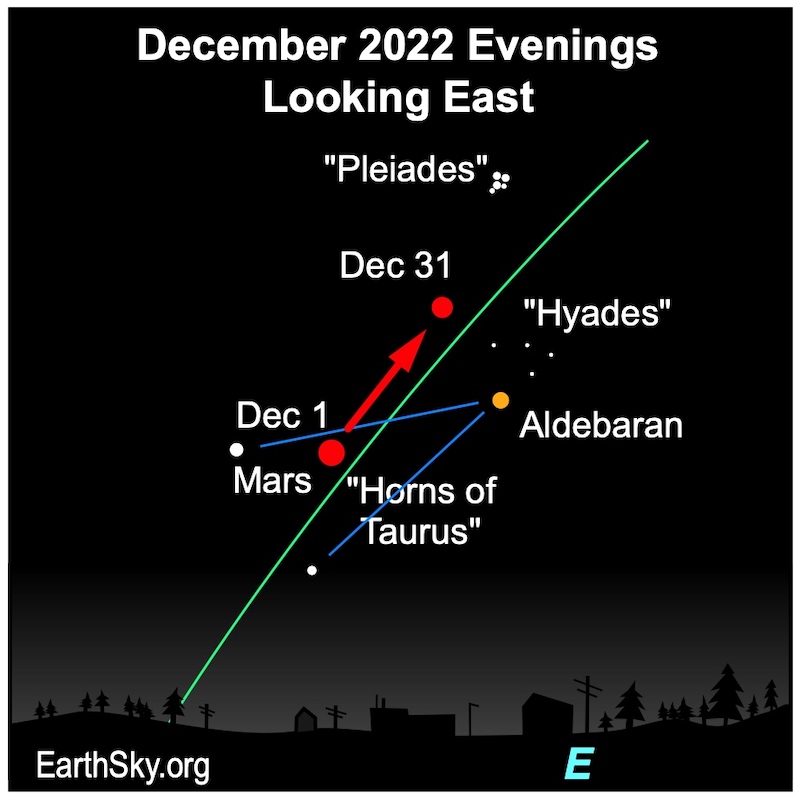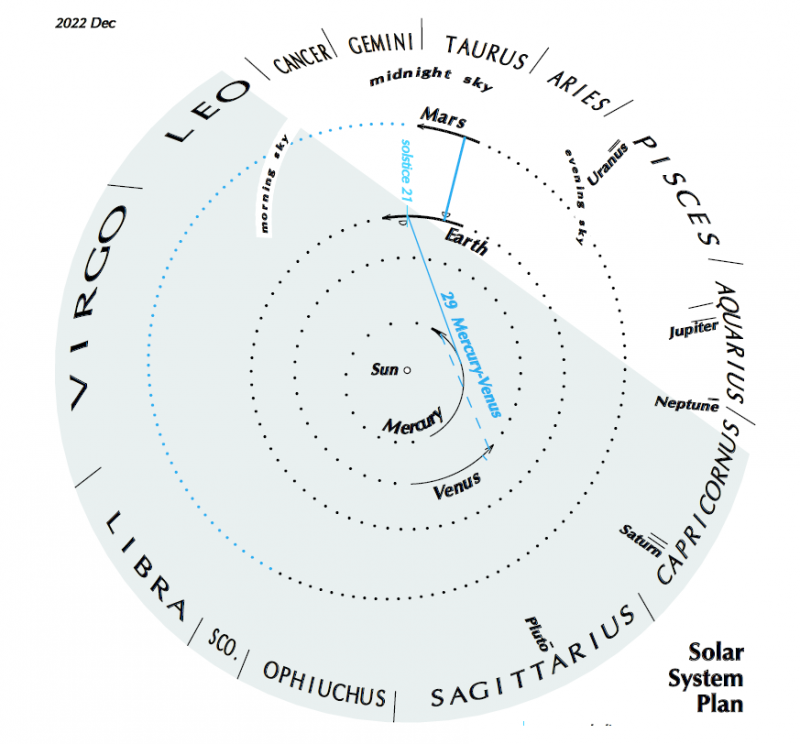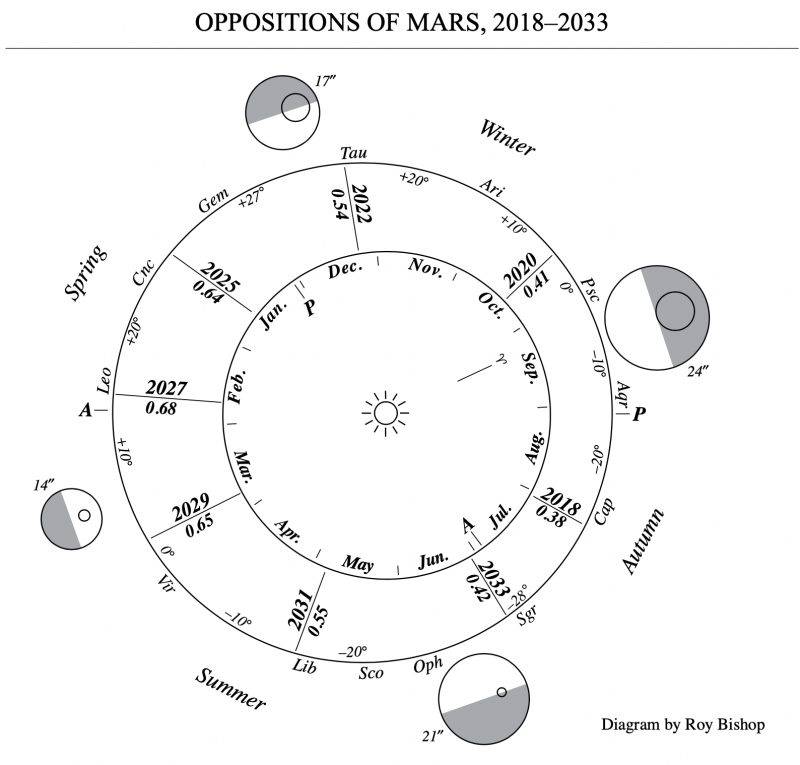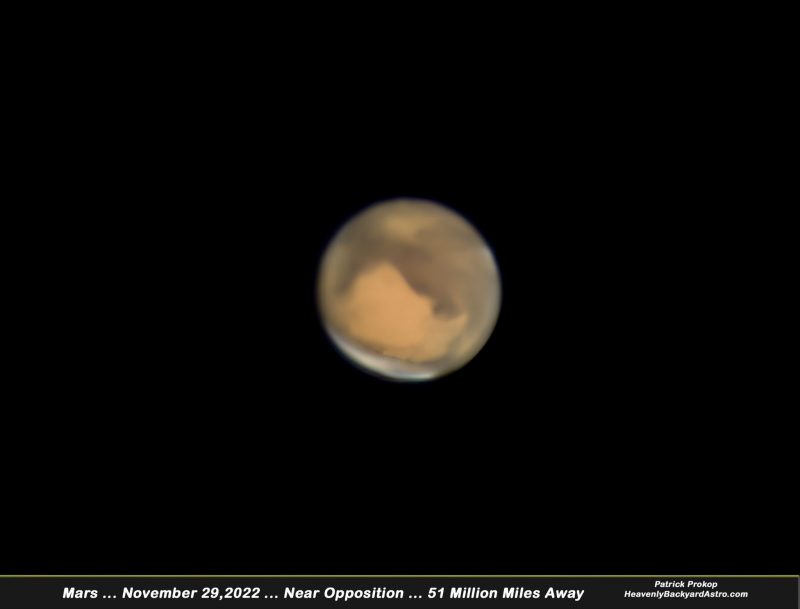Mars is drawing ever-nearer to its opposition on December 8, 2022. That’s when Earth will fly between Mars and the sun, and the space between our two worlds would be the least for this two-year interval.
Mars in 2022
Mars in December 2022: Mars is ascending within the east earlier than true darkness falls. It’s barely brighter now than Sirius, the sky’s brightest star. And it’s noticeably pink in coloration. Mars will proceed to extend in brightness till opposition then start fading by the top of the month. And, every night time, the pink planet will rise earlier.
Opposition for Mars will fall at 6 UTC on December 8, 2022.
Mars was closest to Earth on December 1, 2022 (2 UTC). At its closest, Mars was 4.5 light-minutes from Earth.
At opposition, Mars’ constellation is Taurus the Bull.
Its opposition brightness is magnitude -1.9 (most brightness for 2022). At this level, though Mars is brighter than all the celebs, it nonetheless gained’t be as as shiny as Venus or Jupiter.
By way of a telescope, at opposition, Mars will seem 17.01 arcseconds throughout. Main options on Mars will present floor coloration, plus Mars’ white polar cap might be seen.
Observe: Opposition marks the center of one of the best time to see an outer planet. The pink planet reaches opposition solely about each 26 months. At opposition – as Earth flies between Mars and the sun, putting Mars reverse the sun in our sky – it’ll rise within the east at sundown, attain its highest level round midnight and set at daybreak.
Moon occults Mars on December 7-8
The moon occults, or passes in entrance of, Mars on December 7 or 8, relying in your location. Observers in components of the Americas, Europe and Northern Africa can watch the occasion. Go to In-The-Sky.org for a map of who can see it and when Mars will disappear and reappear out of your location. Mars’ obvious diameter might be 17 arcseconds. And it’ll be shining at magnitude -1.9. So Mars might be large via a telescope and shiny to the attention! The moon might be totally illuminated. Nonetheless, it is best to be capable of glimpse Mars close to the moon in binoculars.
Read more: The moon occults Mars on December 7-8
Mars lunar occcultation map and local times by IOTA
The place to observe Mars opposition and occultation dwell
Finder chart

View from above the solar system, December 2022

Generally, Mars is faint
Mars was in our night sky for a lot of 2021. However, round October, the pink planet disappeared from our sky for a time. Its superior conjunction – when it was most straight behind the sun as seen from Earth – was October 8, 2021. Some weeks afterwards – as each Earth and Mars moved of their respective orbits across the sun – Mars returned to our sky as a faint pink dot within the east earlier than dawn. To make sure, it remained inconspicuous all through the early months of 2022.

Generally, Mars is shiny
Mars steadily brightened within the first half of 2022, first as a morning object. However later, throughout the second half of 2022, Mars shines as a shiny pink ruby within the night sky. It’ll attain opposition – when Earth will fly between Mars and the sun – on December 8, 2022.
Certainly, Mars’ dramatic swings in brightness (and its pink coloration) are why the early stargazers named Mars for his or her God of War.
Generally the struggle god rests. And generally he grows fierce! These adjustments are a part of the rationale Mars is so fascinating to observe within the night time sky.
Want to follow Mars? Bookmark EarthSky’s monthly night sky guide.
Mars isn’t very large
To grasp why Mars varies a lot in brightness in Earth’s sky, first understand that Mars isn’t a really large world. It’s solely 4,219 miles (6,790 km) in diameter, making it solely barely greater than half Earth’s measurement (7,922 miles or 12,750 km in diameter).
Contemplate Mars in distinction to Jupiter, the largest planet in our solar system. Jupiter is 86,881 miles (140,000 km) in diameter. Greater than 20 planets the dimensions of Mars might be lined up aspect by aspect in entrance of Jupiter. Jupiter all the time seems shiny, as a result of it’s so large.
Not so for little Mars. Its extremes in brightness should do with its nearness (or lack of nearness) to Earth.

Future Martian oppositions
When is the subsequent opposition of Mars? The subsequent time Mars will seem at its brightest for that two-year interval in our sky? You guessed it. In January 2025! Try the chart on this page that lists all oppositions of Mars from 1995 to 2037.


Seeing pink
Mars seems as a reddish gentle within the sky and is commonly known as the pink planet. Mars is at present close to two apparent pink stars within the sky, reddish-orange Aldebaran and the well-known pink supergiant Betelgeuse. So, it’ll be enjoyable to check Mars’ coloration and depth of pink with that of Aldebaran or Betelgeuse.
Floor temperature is what determines star colors. The most well liked stars are blue; the best stars are pink. In truth, from hottest to coolest, the colours of stars vary from blue, white, yellow, orange and pink. And whereas the colours of stars is likely to be laborious to detect, some stars – like Aldebaran and Betelgeuse – are noticeably colourful.
Iron oxide
Alternatively, Mars appears red for a special cause. It’s pink due to iron oxide within the dust that covers this desert world. Iron oxide provides rust and blood its pink coloration. Rovers on Mars sampled the Martian dust and decided it incorporates three colours: reds, browns and oranges. So these three colours are what you may even see once you gaze upon Mars.
Do you see pink once you have a look at Mars, Aldebaran and Betelgeuse? Are they the identical coloration? Do you see some other colours of stars?

Backside line: Mars has brightened all through 2022 because it attracts close to its opposition on December 8. Plus, the moon will occult – go in entrance of – Mars on December 7-8.





